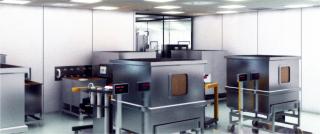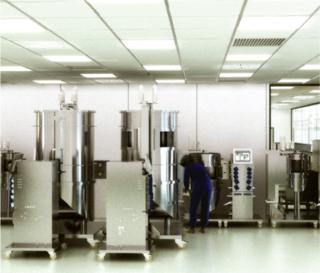Voices of Biotech
Podcast: MilliporeSigma says education vital to creating unbreakable chain for sustainability
MilliporeSigma discusses the importance of people, education, and the benefits of embracing discomfort to bolster sustainability efforts.
December 1, 2012
By 2016, five of the top 10 biopharmaceuticals are expected to be monoclonal antibodies (MAbs). Follow-on (biosimilar) versions of those blockbusters will most likely become available in later years due to patent expiry and the introduction of legislation for biosimilars around the world. Personalized therapies will drive the fractionation of the biopharmaceutical market, trending biomanufacturing toward smaller batch sizes and campaign-based production schemes.
A growing need for flexible, multipurpose, and cost-effective manufacturing will significantly affect the design of production facilities in the future. Demographic and market forces place China in a position to lead the way in this transformation of biopharmaceutical manufacturing.
“Compared with other biopharmaceutical products, MAbs are large proteins that require relatively high doses — and therefore traditionally necessitate high-volume manufacturing facilities,” explains Niels Guldager (senior technology partner in biopharmaceuticals for NNE Pharmaplan, a facility engineering and consulting company focused on pharmaceuticals and biotechnology). “Many biopharmaceutical facilities are still designed as traditional stainless steel facilities with fixed piping and tank layout and large bioreactor volumes. But such facilities require significant financial investment with total installation costs in the range of US$100–300 million.”

New Manufacturing Paradigm
Recent increases in cell culture yields have significantly reduced bioreactor volume requirements, opening the door for manufacturing technologies such as presterilized assemblies of plastic bags, tubing, and filters that are used only once and then discarded. With simplified installation and a concomitant reduction in financial investment, single-use technology can be more appealing than stainless steel technology.
“Combining single-use technology with the currently expected high-titer processes can further reduce the price tag for comparable facilities by 70–90% relative to traditional stainless steel facilities. This combination is being pursued in a number of biopharma facilities in China today. The full effect is truly a new manufacturing paradigm. China is reinventing biotech manufacturing because the future is now in this market,” Guldager says.
Frank Nygaard (MAb manufacturing process specialist at NNE Pharmaplan) elaborates: “Because product-contacting surfaces are used only once, single-use technology runs a much lower risk of batch-to-batch contamination, which is of particular importance in multipurpose facilities. A facility based on single-use technology is easy to reconfigure and can therefore be ready for a new product in a matter of days.” Such flexibility reduces development timelines and thus accelerates the time it takes a product to get to market. In an increasingly fractionated business, the need for speed to secure market shares is more important than initial minimal cost of manufacturing. And with markedly increased cell culture yields, the cost contribution from a manufacturing facility is now limited compared with development costs.
This is where the facility life cycle comes into play. With single-use technology, it becomes possible to optimize facility installations based on anticipated life-cycle stages. For instance, the strategy could be to begin with just one single-use bioreactor to get material for clinical trials before upgrading a facility with additional bioreactors later in anticipation of market supply production while those trials are taking place. When the next product in a company’s pipeline must be developed, the facility can change its life-cycle stage back to clinical production, and the extra bioreactors can be moved to a market-supply expansion facility. Such a strategy is possible because single-use technology is so decoupled from the building itself.
“As an interesting side effect,” Guldager points out, “our environmental impact studies show that single-use technology is less energy-intensive than stainless-steel manufacturing. It may appear counterintuitive, but the emissions from disposing of plastics are more than offset by elimination of the cleaning and sterilization processes required for reusable technology — basically because heating up many tons of water is extremely energy intensive.”
Full implementation of high-yield processes and single-use technology creates facilities with a reduced carbon footprint per kilogram of product made compared with stainless-steel facilities of the 1990s. A further reduction of carbon footprint comes from optimizing energy for local climate conditions and using locally available building materials.
“So to that end, you will most likely be ‘going green’ by going single-use, but the high yield process itself is the most important factor,” Guldager concludes.
Manufacturing Locally
The need for local biomanufacturing capacity is increasing in fast-growth emerging markets as customer bases expand and national initiatives manage existing markets. This trend is amplified by blockbuster patent expiration and the implementation of regulatory legislation for accelerated biosimilar pathways.

Nygaard says, “For biopharmaceuticals, emerging markets are not about low-cost manufacturing hubs, but about being on location to get access to the local market. Consequently, many big pharmaceutical companies as well as local manufacturers are investing in new facilities in these countries.” It can become a matter of using several local facilities instead of one central facility for global supply. Such facilities must clearly meet local manufacturing regulations while increasingly adhering to global good manufacturing practice (GMP) standards.
So there are two new features of biopharmaceutical facilities for the future: They are adaptable to local conditions and yet comply with global regulations as quality requirements are harmonized. Nygaard predicts, “A blueprint facility concept that can be established as interesting markets develop will become an important strategic asset for biopharma players with global aspirations.”
Guldager continues: “You can talk of innovative production techniques in the sense that emerging-market customers are highly innovative and open-minded and therefore capable of leveraging technologies and market dynamics radically. Obviously the traditional stainless-steel production concept may not a
lways be the right solution going forward. But although single-use facilities are still regarded as the facilities of the future in mature markets, they start to emerge as an alternative solution in the blooming biopharmaceutical industry in emerging markets.”
China Reinvents Biomanufacturing
In China, new technologies and quality systems are being taken up rapidly, so this emerging industry region is moving ahead of mature markets. China does not have a specific biosimilar regulatory pathway yet, so new therapies must go through all clinical development phases there. That situation favors development of “biobetters” or “biosuperiors” (products that promise additional advantages rather than simply being similar to innovator drugs). The Chinese patient population can allow for fast recruiting for clinical trials and therefore relatively fast and cost-effective product development.
“Because full clinical data will be produced, we may also see the emergence of new business models based on relatively fast initial product registration in China,” says Guldager, “followed by a strategy to leap-frog back to mature markets and obtain market approval, perhaps based on a limited additional data set. When that happens, the blueprint facility concept will again be a strategic asset to expand capacity for global supply.”
In reality, the important issue is not deciding between stainless steel and disposables, but rather how those technologies can be combined to provide the most productive and cost-effective process in a fast and predictable way. “Choosing one or the other technology concept — or a hybrid of both — depends both on strategic considerations and feasibility studies of each individual case,” Nygaard says. “The future will change biopharmaceutical manufacturing paradigms from stainless steel to hybrid combinations of single-use and stainless steel and complete single-use facilities. That is clear by now, and we see these opportunities being aggressively explored in China.”

Bio on Demand
Today, new biopharmaceutical manufacturing facilities have to be smaller and more flexible, efficient and cost-effective, and capable of adapting quickly to changes in market demand. So it is not really about technology, but rather more about product and process know-how to get to market quickly. “In this respect,” Guldager concludes, “single-use technology is a magnificent enabler. For instance, we can now place an entire small-scale clinical production line inside a 100-m2 environment with these technologies. Biotech on demand — the ability to rapidly establish local manufacturing capacity based on new market opportunities — will become an important capability for successful companies in the future. And single-use technology combined with next-generation facility design will do just that.”
About the Author
Author Details
Niels Haxthausen is vice president of sales and marketing for NNE Pharmaplan, Nybrovej 80, 2820 Gentofte, Denmark; 45-3079-2725, fax 45-4444-3777; [email protected]; www.nnepharmaplan.com.
You May Also Like